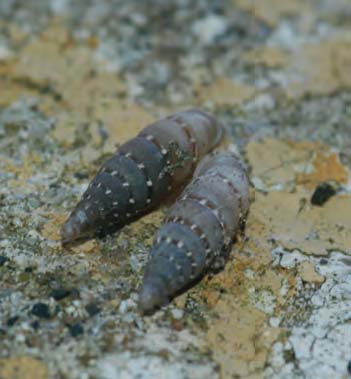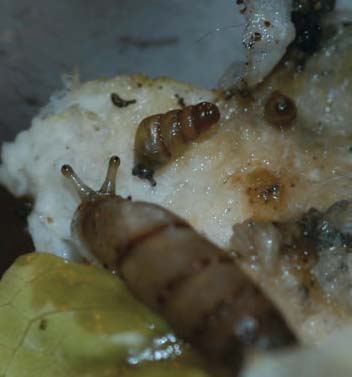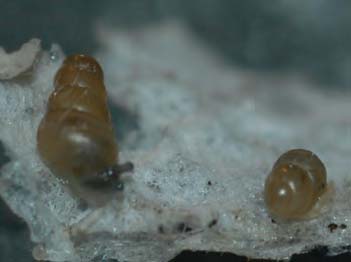|
In September 1989 I went to a wedding reception at the Gibraltar Garrison Library (Fig 1). Ever on the lookout for snails and slugs, I walked around the Library Gardens and found 3 specimens of a clausiliid on a limestone wall, about 1 metre from ground level. This was a big surprise: I knew clausiliids had not been recorded from Gibraltar, nor indeed from anywhere else in southern Iberia. Adrian Norris, on a visit to Gibraltar a few years later, confirmed these live-collected specimens as Papillifera papillaris (Müller, 1774). Another social function at the Library, this time a retirement in May 2006, found me once again searching on the walls and vegetation. There, on the same wall I had originally found the snails 17 years earlier, were about 10 live adults crawling around! (Fig 2). I took home a few to keep and study. The snails live happily in their new home that I set up with soil, empty Rumina decollata (Linnaeus, 1758) shells (in which the snails love to shelter), and rocks covered with algae. The snails feed on lettuce but prefer algae. Over the years I have perfected an algal-growing system for feeding snails that is rapid and foolproof. I place rocks in a bowl with water, put this out in my garden (also works indoors under a lamp) and in a couple of days you have an edible algal film on the rocks. I keep the Papillifera habitat container in my garden (along with my other snail habitats such as Iberus, Cantareus etc.) and throughout the hot summer the snails buried themselves in the soil, not appearing until October, a few days after the first rains. I always place paper with all my snails (plain white kitchen roll is best) and change this weekly. When I picked up the paper to change it, I was surprised to see over 30 tiny baby Papilliferas hidden in the folds! (Fig 3 & 4). Unknown to me, some breeding had taken place, and there were baby snails everywhere. By February 2007 many of the new snails were feeding well and had reached sub-adult size. They are fascinating to watch as they crawl about on the rocks in their new home and I’ll continue to observe them as they grow. The Clausiliidae (door snails) are widespread throughout the western Palaearctic, southern Ethiopia, and the oriental, northern and western Neotropical region. In Europe they reach maximal diversity in the Balkans and Caucasus. P. papillaris has a western and central Mediterranean distribution and has been recorded from the Balearics (Süleyman, 2005) . It prefers rocky substratum, walls (covered in lichen, mosses and vegetation), and is common in anthropogenic habitats (with some records from these habitats in North Africa). I wanted to find out P. papillaris’ distribution in Iberia and did an extensive literature survey, and emailed malacologists familiar with Iberian malacofaunas to see if there were any records for this species. Bech (1990) cites early records from 1929 for Tarragona and Barcelona, and records from 1967 for Barcelona. These are the only records for this species I was able to find. Other malacologists have not found it in Iberia, and have no further records. I have never found the species in southern Iberia, even after many years of fieldwork at many locations. I have sampled in Barcelona as well, but have not found it there. The species is subject to anthropochorous dispersal (Giusti et al., 1995) and has been transported to many areas in the Mediterranean Basin and other areas in this way (Fechter and Falkner, 1993). Örstan (2006) has found it in Istanbul, and suggested it may have been introduced from Italy on marble as early as 330AD. It has recently been recorded for the first time in Britain as well (Ridout Sharpe, 2005). The snails were found in a country house at Cliveden, Buckinghamshire, and seem to be confined to a balustrade that was brought from a villa in Rome in 1896. The colony is made up of about 100 snails, thought to have been brought in with the balustrade. Anthropochorous dispersal is the most likely explanation for its presence in Gibraltar, too, and the Garrison Library’s history substantiates this. The Library was founded in 1793 by Captain (later Colonel) Drinkwater and is steeped in history. Its fine rooms filled with valuable tomes and artwork provide a sharp contrast with the modern world. The preface to the first minutes of the Garrison Library Committee takes us back to another age, and explains the purpose of the institution (Anon): Several Gentleman who have long lamented the want of a Public Library in Gibraltar are desirous of forming a Society, for the purpose of, either establishing one by Subscription on a Liberal and permanent principle, or if that Idea should be thought to embrace too serious an Undertaking, to adopt any other Scheme, that may be recommended as more eligible to procure them the perusal of the best and most entertaining modern Publications. The Library is an important part of Gibraltar’s heritage. But it has not remained a static example of past times; instead it has adapted and changed throughout its 200-year history. Whilst maintaining its charm and character it is now the location of the printing and binding department of the Gibraltar Chronicle, the second oldest English newspaper in the world. And the studious environment provides just the right setting for book launches, poetry recitals and the occasional wedding reception. The building may even become the new venue for the Gibraltar Parliament. During its military days, when officers and their wives dabbled in natural history and gardening, plants and ornaments from Mediterranean locations would have been brought into the Gardens to augment its collections. Perhaps one of these plants, or ornaments, may have included a few P. papillaris and that is how they first came to Gibraltar. This, and introductions elsewhere, highlight an interesting aspect of clausiliid ecology. Individuals of these molluscs have very reduced dispersal abilities that are mostly dictated by the proximity of suitable rocky outcrops on which the snails depend for food and shelter. Some snails spend months on a single rock and cannot cross even small distances that are of unsuitable habitat. This has resulted in extreme morphological diversification among these interesting snails (Gittenberger, 1991; Uit de Weerd et al., 2005). Scale, another very important concept in land mollusc ecology, is also highlighted by these snails. The scale at which the snails are sampled, and the sampling method used, may determine whether or not they are recorded. A detailed and extensive quantitative survey I carried out in October 2006 at the Gardens detected the snails at several locations, but showed that the snails were very clumped in their distribution. For this type of species a random quadrat technique may fail to turn up any individuals, and a timed direct search method (covering a larger area) is more appropriate (Menez, 2001; Cameron and Pokryszko, 2005). What is remarkable is that the snails have not moved beyond the Gardens into surrounding areas. These areas have the same habitat and support the same molluscan assemblages. This finding, in conjunction with the reduced area where the colony in Britain exists, provides further evidence that these snails, do indeed have limited dispersal abilities. Because of the protected status of the Garrison Library and its Garden, we can be confident that we’ll continue to have a viable population of these interesting snails here in Gibraltar for a long time to come. References Anon. Undated. The Gibraltar Garrison Library. Gibraltar: Gibraltar Chronicle Limited. Bech M. 1990. Fauna Malacològica de Catalunya. Mol_luscs Terrestres I d’aigua dolça. Treballs de la Institució Catalana d’Història Natural. Núm. 12. Barcelona. Cameron RAD, Pokryszko BM. 2005. Estimating the species richness and composition of land mollusc communities: problems, consequences and practical advice. Journal of Conchology 38: 529-547. Fechter R, Falkner G. 1993. Moluscos europeos marinos y de interior. Barcelona: Blume. Gittenberger E. 1991. What about non-adaptive radiation? Biological Journal of the Linnean Society 43: 263-272. Giusti F, Manganelli G, Schembri PJ. 1995. The non-marine molluscs of the Maltese Islands. Monografie XV. Torino: Museo Regionale di Scienze Naturali. Menez A. 2001. Assessment of land snail sampling efficacy in three Mediterranean habitat types. Journal of Conchology 37: 171-175. Örstan A. 2006. The clausiliid snail Papillifera papillaris in Istanbul, Turkey. The Archaeo+Malacology Group Newsletter 9: 6-7. Ridout Sharpe J. 2005. Papillifera papillaris (Gastropoda: Clausiliidae): a new record for Britain. The Archaeo+Malacology Group Newsletter 7: 7. Süleyman G. 2005. The land snails (Gastropoda: Pulmonata: Stylommatophora: Clausiliidae) of the ancient cities in the Marmara, the Ege (Aegean) and the Akdeniz (Mediterranean) regions of Turkey Burçin Askim. The Archaeo+Malacology Group Newsletter 7: 1-3. Uit de Weerd DR, Schneider D, Gittenberger E. 2005. The provenance of the Greek land snail species Isabellaria pharsalica: molecular evidence of recent passive long-distance dispersal. Journal of Biogeography 32: 1571-1581. |
Fig 1 The Gibraltar Garrison Library
Fig 2 Two adult Papillifera papillaris (Muller, 174) on a lichen-covered limestone wall in the Gibraltar Garrison Library Gardens
Fig 3 Adult and young Papillifera papillaris (Muller, 1774) in captivity
Fig 4 Young Papillifera papillaris (Muller, 1774) bred in captivity
|




